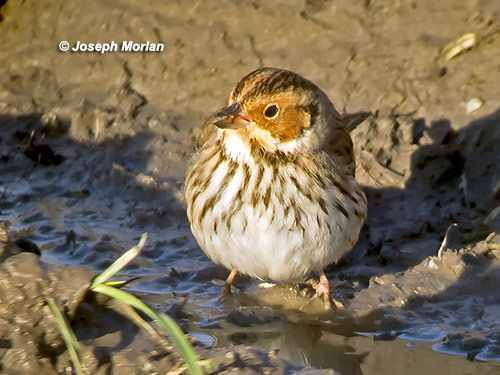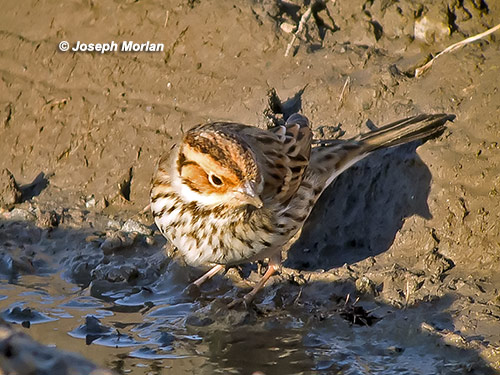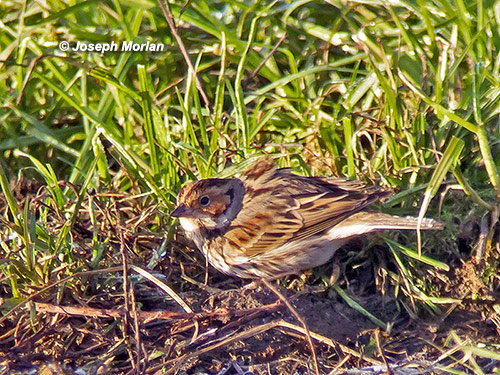
Drinking at puddle along road. Note orange ear coverts and crown.
Little Bunting (Emberiza pusilla)
McKinleyville, Humboldt Co., CA
19-20 December 2013
Joseph Morlan
Photos © 19-20 December 2013 by Joseph Morlan. All rights reserved. Click
here for larger images.

Drinking at puddle along road. Note orange ear coverts and crown.
This individual was found here by Keith Slauson on 12 December and seen daily since then. Robbie Fischer and I arrived at the south end of Fischer Road about 2:30pm on 19 December. There we met Rob Fowler who has been keeping track of this bird, and Curtis Marantz, Matt Brady, Dan Maxwell and Amy Patten who had driven up from Southern California. Birds were very skittish because of gale force winds that made viewing difficult. Curtis and I were talking in the lee of Rob Fowler's car when Curtis spotted the bunting fly right in front of us. It disappeared in weeds by the fence behind the roadside puddle. All observers gathered and were treated to outstanding, close range views of the bird drinking from the puddle. Excellent photos were obtained by Rob and Curtis. While Curtis was busy taking photos, I borrowed his Kowa scope and took these (top two) photos by hand-holding my camera up to the eyepiece of Curtis's scope. The bird flew across the road where it disappeared in the vegetation. We waited for a while but the winds persisted making birding conditions very difficult. We decided to give up and try again the next morning.
The next day, 20 December, we arrived at the spot around 8:30 am where a group of birders from Portland, Oregon had located the bird fairly close to the road across from the puddle. Conditions were much better, with no wind and clear skies. Nevertheless, the Little Bunting proved tricky to see and even more difficult to photograph. The bottom two photos were obtained and give a sense of the way the bird crawled through the vegetation acting like a small rodent. It visited the puddle briefly but spent most time in the dense vegetation.

Some dusky streaking in the median line of the crown. Bold streaking across breast and flanks.
Description
The following description is based on memory and on photos:
A small compact sparrow with a strongly patterned head and crisply streaked breast. About the size of Savannah Sparrow (Passerculus sandwichensis) or slightly smaller. The head was suffused with orange, strongest on the ear coverts but including the supercilium and median crown strip. Two dark brown lateral crown strips were evident. At close range these stripes appeared flecked with buffy orange. The dark gray-brown eye was surrounded by a whitish eyering. The rear of the ear coverts were outlined in black, recalling the face pattern of Lapland Longspur (Calcarius lapponicus). A faint pale spot could be seen at the rear of the ear coverts just inside the dark frame. The mustachial (malar) area was white and extended around the nape forming an unstreaked gray nuchal collar. The chin and throat were white framed by obvious dark lateral throat stripes. The underparts were white with well defined crisp white streaks across the breast and down the sides and flanks. However the rest of the underparts (belly, crissum) were unstreaked. The back was gray with crisp dark-brown streaks. Primary projection was fairly short. Tertials were dark on the inner webs and rusty-brown on the outer webs. The longest tertials had dark notches within the brown outer webs near the base. Greater coverts were dark on the inner webs and outlined with gray brown. Median coverts were tipped with gray and had teardrop shaped dark intern markings not pointed at the tips. No obvious wing-bars. Uppertail coverts were gray with dark shaft spots. Tail was moderately short, dark with brownish fringes. Outermost tail feathers had some white visible in flight, but not studied critically. The bill was short and pointed, sparrow-like. The feet and legs were bright pink.

Back feathers fluffed. Gray hind collar and dark outline to rear of ear coverts. Ice crystals on tail.
Discussion
Status in California
This species has previously been recorded in California three times:
Elsewhere one was photographed in Joseph, Wallowa County, Oregon 28 January - 25 March 2013 (Contreras & Tumer Western Birds 44:243-245, 2013). There is also an 8 October 2008 record for Rancho San Jose de Castro, Baja California Sur, Mexico (Radamaker & Powell Western Birds 41:55-58, 2010; ). The species is now considered to be a nearly annual Fall vagrant in Western Alaska (Lehman Western Birds 36:2-55, 2005; updated PDF).
Identification
Identification is relatively straightforward. The Rustic Bunting (Emberiza rustica) is larger, has dull brown, not rich chestnut cheeks, and has rufous, not dark brown streaking on its underparts. Chestnut-eared Bunting (Emberiza fucata) has a gray crown with dusky streaks and is unrecorded in the Americas.

Creeping through vegetation like a mouse.